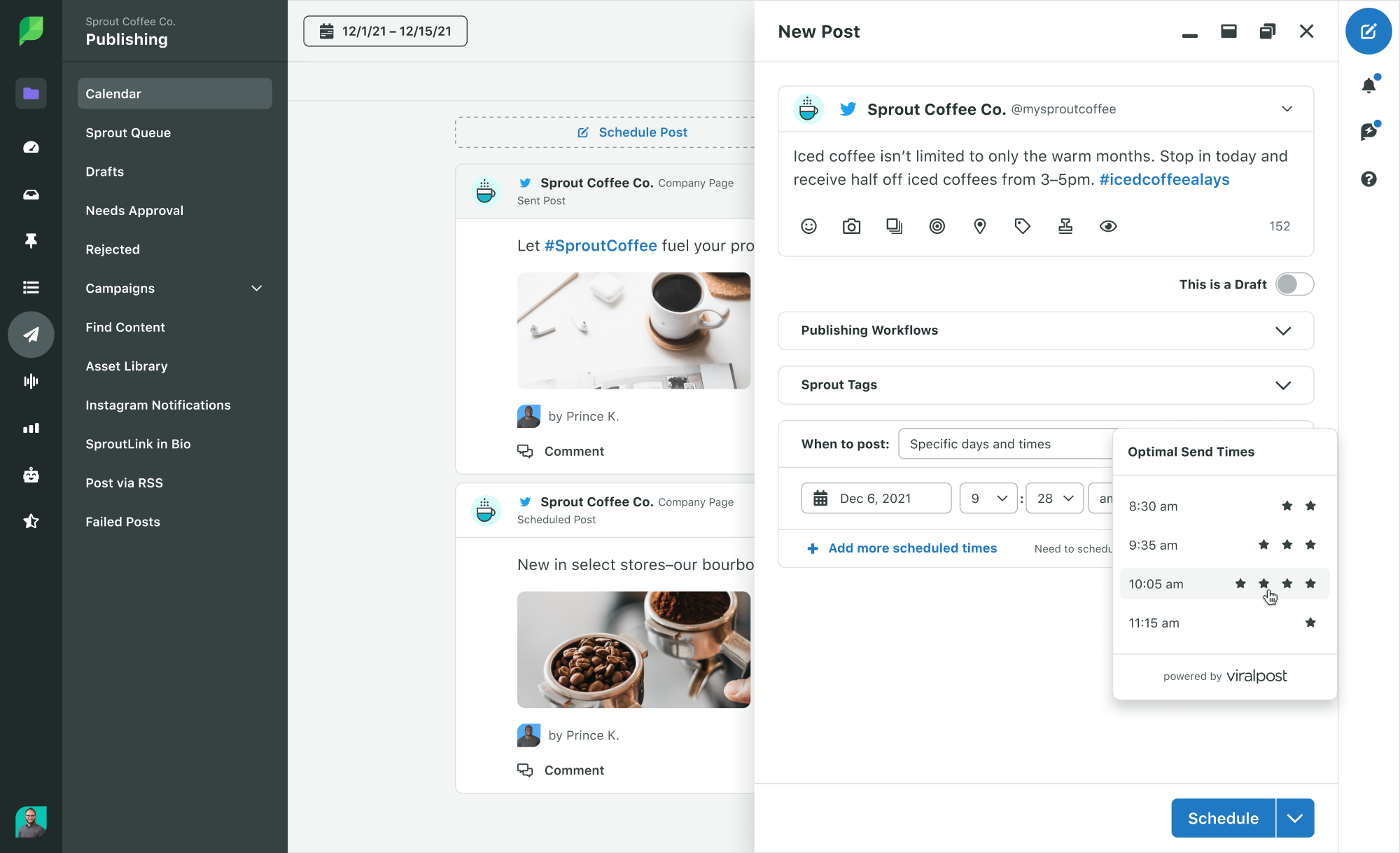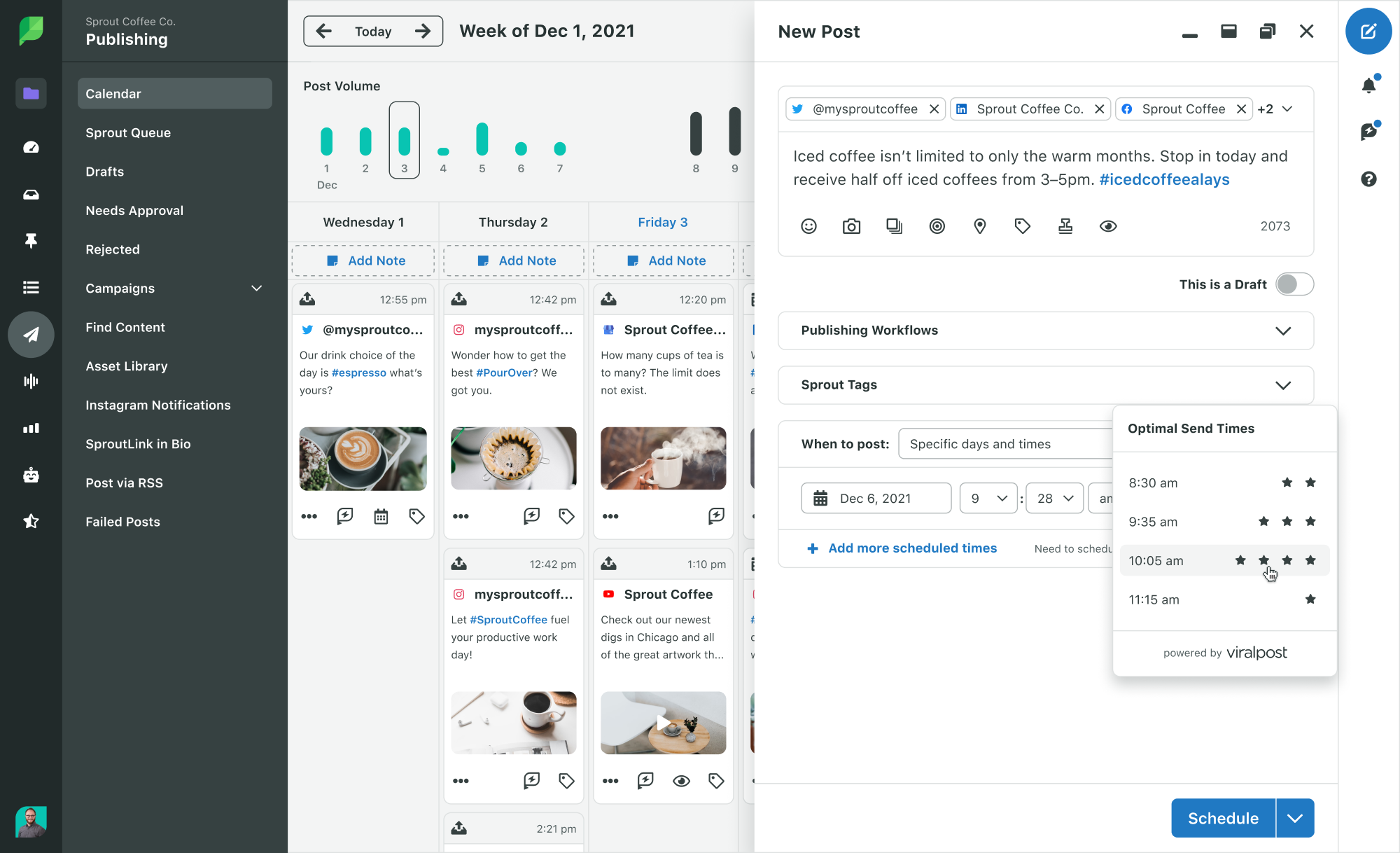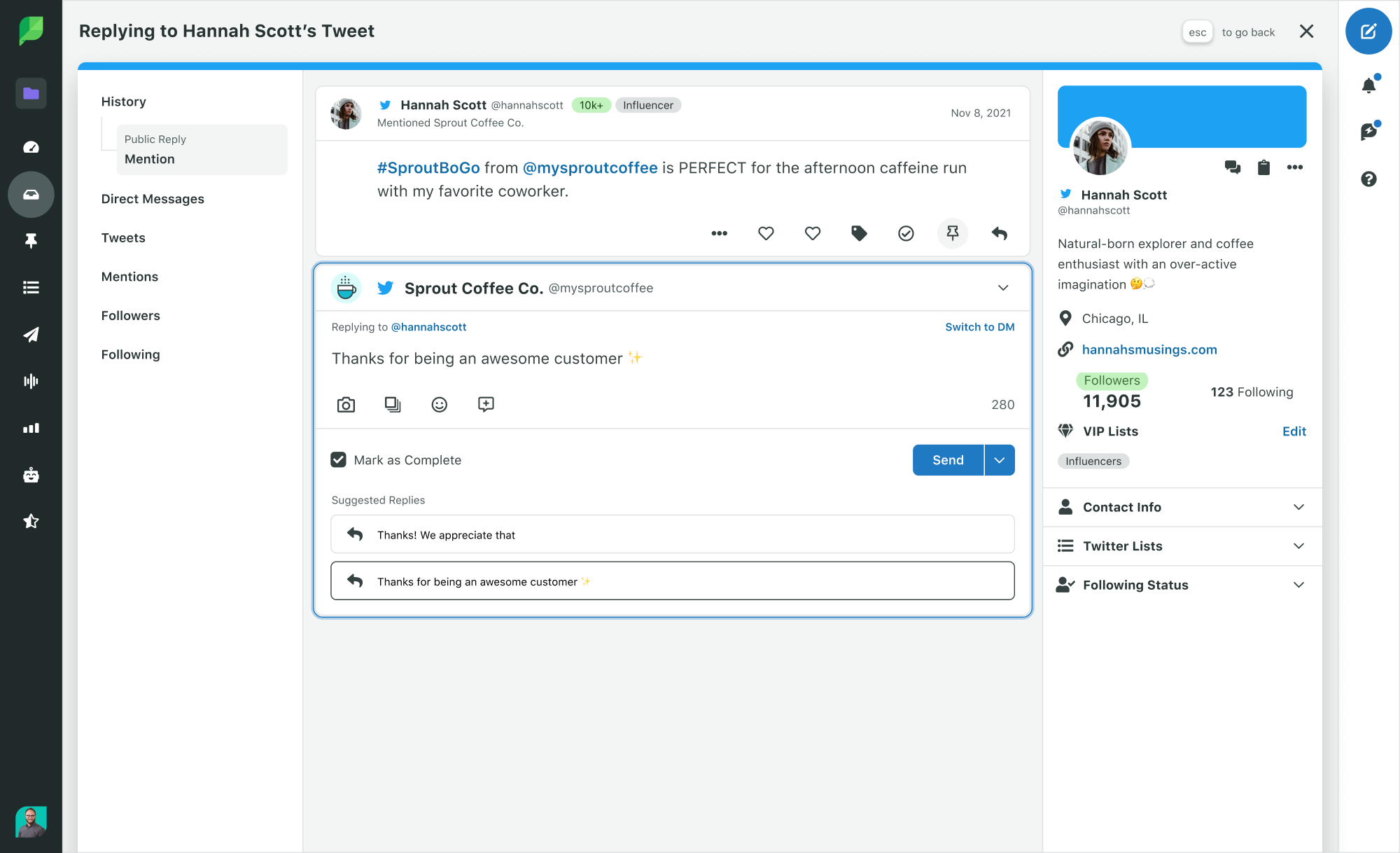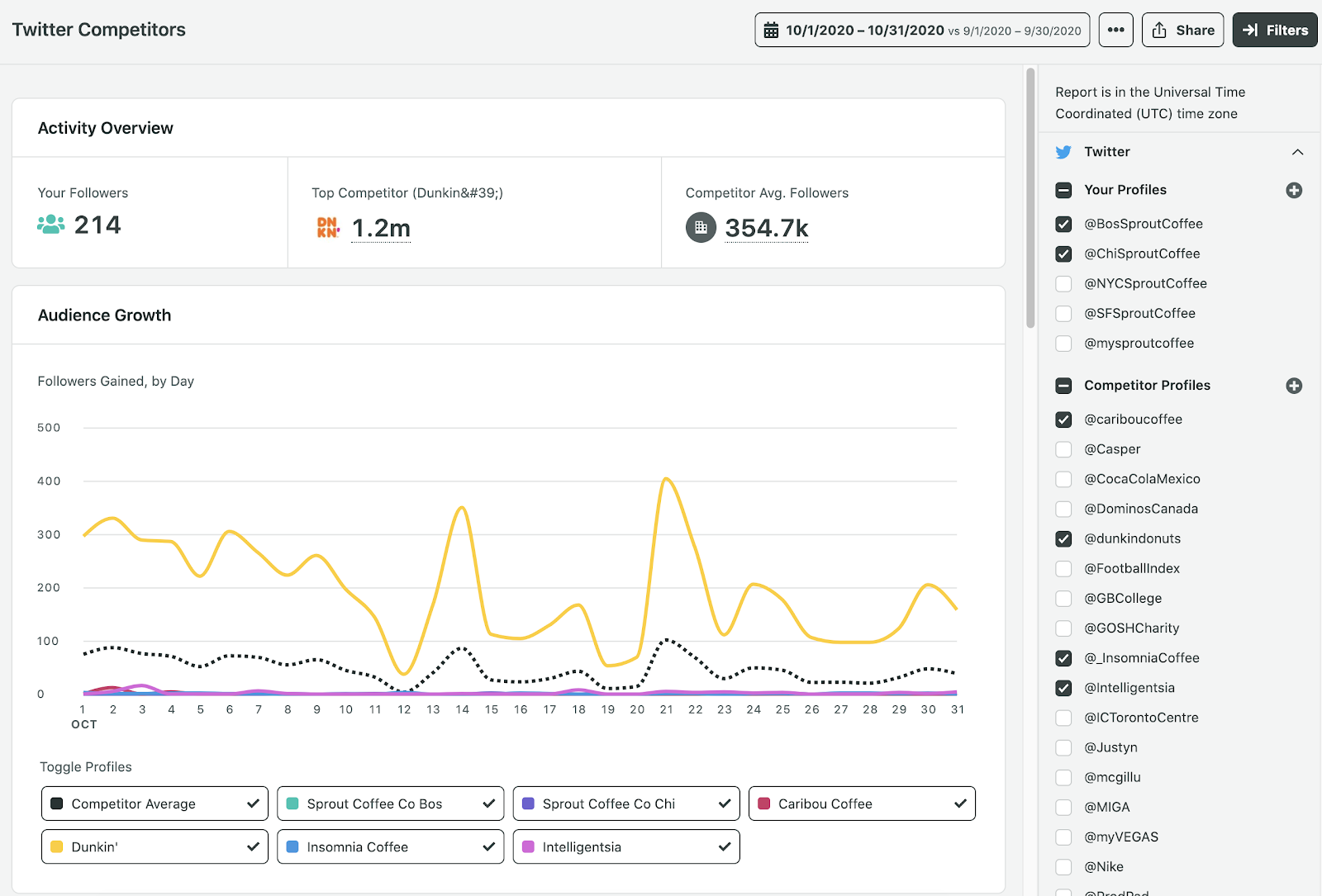
Twitter Marketing
How to create a Twitter marketing strategy for your brand
Reading time 11 minutes
Published on September 8, 2023

Table of Contents
Twitter (rebranded as "X") started out as a place for people to share their every thought. Now it’s turned into a powerful marketing platform that lets brands connect with their audience. Boasting 217 million monetizable users per day, it’s easy to see why companies keep using Twitter after all of this time.
But it’s no longer enough to send out the occasional Tweet about a trending topic. Brands need to be more intentional with their social media marketing strategy on Twitter. This will allow them to stand out and keep their audience engaged.
That’s exactly what we’ll discuss in this guide. Let’s take a look at the step-by-step process of creating a Twitter marketing strategy to grow your presence and drive engagement.
What is Twitter marketing?
Twitter marketing is the process of promoting your brand and its products or services through Twitter. It involves establishing an effective social media marketing strategy to create and publish content on the platform. When you market on Twitter, you need to publish the right Tweets at the right time to attract the right audience.
But before you start Tweeting, you need to consider the key elements of a successful Twitter marketing strategy. Here's a quick rundown:
- Audit your accounts. This will give you a baseline to work from.
- Check out your competitors' strategies. Look at what their audience likes and consider their brand voice.
- Set clear, measurable goals. Be specific about what you want to achieve on Twitter.
- Compare Twitter analytics data to your goals on a regular basis to judge your progress.
- Establish your brand voice.
- Use a content calendar to help you develop and maintain a consistent content strategy.
It doesn't stop with posting content. Twitter marketing requires a plan to engage and interact with your audience. Twitter is a conversation-based network. It's important to create a two-way conversation with followers by replying to Tweets or direct messages.
In fact, you increase your chances of appearing in non-followers’ feeds by interacting with your audience’s replies and mentions. Doing this will improve your visibility as well as brand awareness. These are only a few of the many benefits of Twitter for brands.
Some Twitter marketing strategies may include a plan to advertise on the platform. This involves delivering targeted ads or promoted Tweets to a relevant audience. We'll get into the details of those later in this guide.
However you approach Twitter marketing, make sure your strategy is aligned with your business goals and the style of the network. With that said, use these 10 tips to guide you through your Twitter marketing strategy:
10 Twitter marketing tips to influence your strategy
1. Strengthen your brand Twitter profile
When you use Twitter for business, it's essential that you have a captivating profile.Your brand voice, your brand’s “personality,” begins here. This is where customers come to see what you’re all about. So if your Twitter business profile is not representing you well, it’s time to give it a good edit.
Begin with your banner, or header photo. It’s likely the first thing a customer will see when they visit your profile. What does it convey to the viewer? Is it consistent with who you are as a business? If not, it’s time for a change.
Once you have that to your liking, look at your profile picture. Since it shows up on every Tweet, you want it to be something that is quickly and easily associated with your business, such as your logo.
Next, analyze your bio. You may only have 160 characters to work with, but it is imperative that you use them to engage your profile visitor with your brand. This is a great opportunity to let your brand voice shine through. And don’t forget to let people know what your company has to offer.
Finally, take a good look at your pinned Tweet. Does it reflect what’s going on with your company right now? Or is it last month’s news? Don’t waste this opportunity to make an impression on your profile visitors.

2. Audit your Twitter account
If you already have an existing Twitter account, you should run a Twitter audit.
An in-depth review of your Twitter analytics will allow you to take stock of what's working and what's not. You'll want to know things like:
- Follower growth rate
- Whether you're attracting your target audience
- How effective your posting frequency is
- What types of content are resonating best with your audience
Twitter analytics tools like Sprout Social can do the hard part for you and help you analyze:
- Hashtag performance
- Individual Tweet performance
- Individual Twitter audience
Knowing which Tweets are performing the best will give you an idea of the type of content that your audience is most interested in seeing. You can use this information to create a strategy to give your audience what they’re looking for in your content. This will ultimately allow you to maximize the reach and engagement you with your Tweets.
One way to audit your Twitter account is to look over your analytics manually from your Twitter Analytics dashboard. Here’s the step-by-step process to access this dashboard:
- When you're logged in, click on the “More” button from the left-hand panel of your Twitter homepage.
- Expand the “Creator Studio” option and select “Analytics.” This will open the Twitter Analytics dashboard.
- From here, find “Tweet Highlights” and select "View all Tweet activity". This will open a graph of all the impressions you earned for your Tweets within any given time period.
- Below the graph, you can see the impressions, engagements and engagement rates for each Tweet. Click on “Top Tweets” to see your best-performing Tweets. Check out the performance of your promoted Tweets by clicking on the “Promoted” tab.

If you're using Sprout Social to manage your Twitter profile, you can access your Twitter analytics alongside your other social media data in the Cross-Network Post Performance Report. Find your impressions, potential reach, engagements and engagement rate per impression for each of your Tweets in this report.

3. Find your brand voice on Twitter
Audiences on Twitter are looking for brands that Tweet authentically and stay true to their brand voice. It can be easy to jump on the latest trends to try to appeal to the masses on Twitter. But don’t do this at the expense of losing your brand voice. Your Twitter presence can be more playful and casual than on LinkedIn or Facebook. However, it should still be authentic and consistent with your brand voice as a whole.
Innocent Drinks has nailed its brand voice on Twitter. Going through the brand’s feed, you can immediately see the brand’s persona shine through. The brand voice is fun, friendly, honest and approachable.

Remember, an engaging brand voice is essential, but don’t jump on trends just for the sake of staying relevant. Twitter users are especially astute when a brand is being inauthentic in an attempt to generate attention. In other words, don’t try too hard to fit in and instead, but instead, stay true to your brand voice.
5. Run Twitter ads for optimal reach
Using Twitter advertising is a great way to reach your audience in a more direct way than waiting for organic reach. Promoted Tweets can expand your reach more quickly.
They allow people to discover your profile, even if they don’t follow your brand or hashtags. When you use a promoted Tweet, your Tweets show up on the timelines of people who share interests with your audience.
You pay a monthly fee as long as you want the promoted Tweet to stay up. Users can interact with promoted Tweets in the same way they interact with organic content. The only difference is that promoted Tweets are labeled, so users transparently know it’s a paid ad.
Twitter advertising is objective based, with your brand only paying for those actions which align with that goal. If your brand's objective is reach, the recommended ad formats would be image ads, video ads, carousel ads and moment ads. For this objective, you would pay for every 1,000 Tweet impressions. And, you can set a cap on your CPM.
Here, ConvertKit uses a promoted Tweet to bring attention to its paid newsletter service.

6. Tweet when your audience is most active
At the same time, Twitter moves so fast that something you Tweeted 30 minutes ago may very well be invisible to your followers. This makes it crucial to post at a time when your followers are most likely to see and engage with your Tweet. This would allow the Twitter algorithm to prioritize your Tweets and display them to an even bigger audience.
Sprout’s study on the best time to post on Twitter revealed that Tuesday through Friday, between 9 AM and noon are the best times to post.
Sprout’s ViralPost™ feature looks at your audience’s activity and chooses the most optimal times for you to post depending on when your followers are most active.

7. Maintain a content calendar and schedule Tweets
The right Tweet posted at the right time has the potential to generate massive engagement and virality. But you can’t possibly wait for your audience to be active every time you send out a Tweet.
Intentionally scheduling your Tweets ahead of time to makes publishing more efficient.
Knowing the right time to Tweet makes scheduling a consistent flow of Tweets much more manageable. It’s important to be as consistent as possible on Twitter. Best practices recommend Tweeting at least once per day.
Some brands Tweet up to 15 times per day to stay in front of their audience. Best practices can differ across industries. It depends on your resources and social media strategy to determine how frequently you can create and publish new content on Twitter.
Use Sprout’s publishing tool to schedule your Tweets to go out at optimal send times. This allows you to schedule your Tweets for an entire week or month, making it easier to maintain consistency.

8. Engage with your Twitter followers
Twitter is all about creating a two-way channel of communication with your audience. It’s important to create content that encourages your audience to engage with your Tweets. You want to create content that encourages your audience to engage with your Tweet, which can help you get more followers on Twitter.
Meanwhile, you need to make sure that you’re engaging with people who are Tweeting about your brand individually. If someone mentions your brand or responds to a Tweet, make sure you’re responding to their message in a timely fashion.
It’s a good idea to have a dedicated community manager handle these requests. This will help prevent responses from falling through the cracks.
At Sprout, we closely monitor any brand mentions and look for opportunities to engage. Whether it’s a question about student programs, a support-related problem or a positive mention, we make it a point to respond.

Another way to create engagement with your followers is to ask questions. You can do this by creating a survey on Twitter directly or by just asking a question and Retweeting people’s responses.
ClearVoice regularly posts Twitter surveys to ask questions to its audience. These may be about their content preferences and strategies. This gives the brand valuable research information to understand its audience better.

Try out Sprout’s Suggested Replies feature
Sprout’s Suggested Replies feature can help simplify the process of responding to your audience. It lets you create canned responses for commonly asked questions on social media. Team members can then edit these with a personal touch. These responses give the people managing the profile behind the scenes a simple way to handle any volume of inquiries they get on Twitter.

9. Set measurable Twitter goals and track your analytics
Your Twitter marketing strategy needs measurable goals that will keep your plan on track. Instead of publishing Tweets and hoping for the best, set goals and objectives for Twitter. These goals should help your business meet its overall marketing goals. Goals for Twitter can include:
- Building an engaged following to increase brand awareness
- Generating leads by directing traffic to an offer or email list
- Increasing traffic to your website by posting links to blog content
- Building brand loyalty by providing excellent customer service on Twitter
- Networking with influencers and industry thought leaders to create more connections
Once you’ve determined your Twitter goals, set aside time every month to measure those goals. Make sure you know which Twitter metrics to track for each goal. Then you can analyze what’s working with your strategy and what needs tweaking.
Native Twitter analytics will allow you to see your profile growth, and analyze your Tweets through metrics such as engagements, impressions, clicks, replies and Retweets. But a Twitter tool like Sprout can make the process nearly effortless. Once you've set your goals, you can implement them and track their progress within an all-in-one tool.
10. Analyze your competitors
Competitive analysis is great for keeping track of your competitors' marketing efforts on Twitter. What are your competitors posting? How often do they post? To help you get answers, you can use Sprout's Twitter Competitors Report. The Twitter Competitors Report lets you track and compare the performance of other Twitter profiles against the average of the profiles being compared.

This information can help you shore up your own strategy by revealing areas where you can improve.
Unleash the power of Twitter marketing
A solid Twitter marketing strategy gives you leverage in a competitive market. It helps you stand apart from the crowd while keeping your audience engaged. More importantly, it enables you to stay top of mind for your audience.
Use the steps outlined above to get started with Twitter marketing. And make sure to invest in a robust social media management platform like Sprout to make your job more efficient. Request a personalized demo to see how Sprout can help.
Use of Twitter nomenclature across Sprout refers to newly rebranded X platform and related terminology.
Twitter marketing FAQs
How is Twitter used for marketing?
Twitter marketing is the process of promoting your brand and its products or services through Twitter. It involves a well-established social media marketing strategy to create and publish content on the platform.
Is Twitter still effective for marketing?
Yes, Twitter is still effective for marketing, especially when using available advertising features. Twitter advertising allows people to discover your profile, whether they follow you or not. You’ll grow your audience, generate leads, promote your business and much more with Twitter marketing.
What makes Twitter such a powerful marketing tool?
Twitter boasts 217 million monetizable users per day, so it’s easy to see why companies keep using Twitter after all this time. Businesses are able to interact and engage with customers for promotional purposes. And they can use Twitter for customer care efforts as well.
Additional resources for Twitter Marketing
10 Twitter automation tools for your brand in 2024
How to create a Twitter marketing strategy for your brand
How to use Twitter advanced search to get more leads for your brand
16 Twitter tools to boost your brand’s marketing
How to use Twitter communities to grow your brand
10 meaningful ways to get more Twitter followers
What is Twitter Spaces? – Bring your Twitter conversations to life with audio
17 Engaging ideas for what to post on Twitter
Facebook vs Twitter: Which is best for your brand?
26 Twitter tips for beginners you’ll wish you knew sooner
5 Twitter Campaigns Your Business Can Learn From















